In our biggest group test to date, we pushed 30 of the hottest e-mountainbikes of the season to their limits, collecting some very exciting findings in the process. What are the most interesting eMTB trends of 2023? Where is the potential and where are the risks? What should you know before buying a new bike?
- Long live this growing diversity!
- Don’t trust the looks, nor the hard numbers!
- Top range of the ≠ top performance
- New eBike generation = new problems?
- The two faces of integration
- Enough is enough! We want more battery options, not bigger batteries!
- Which practical features should every eBike have?
- Click here for our big comparison test
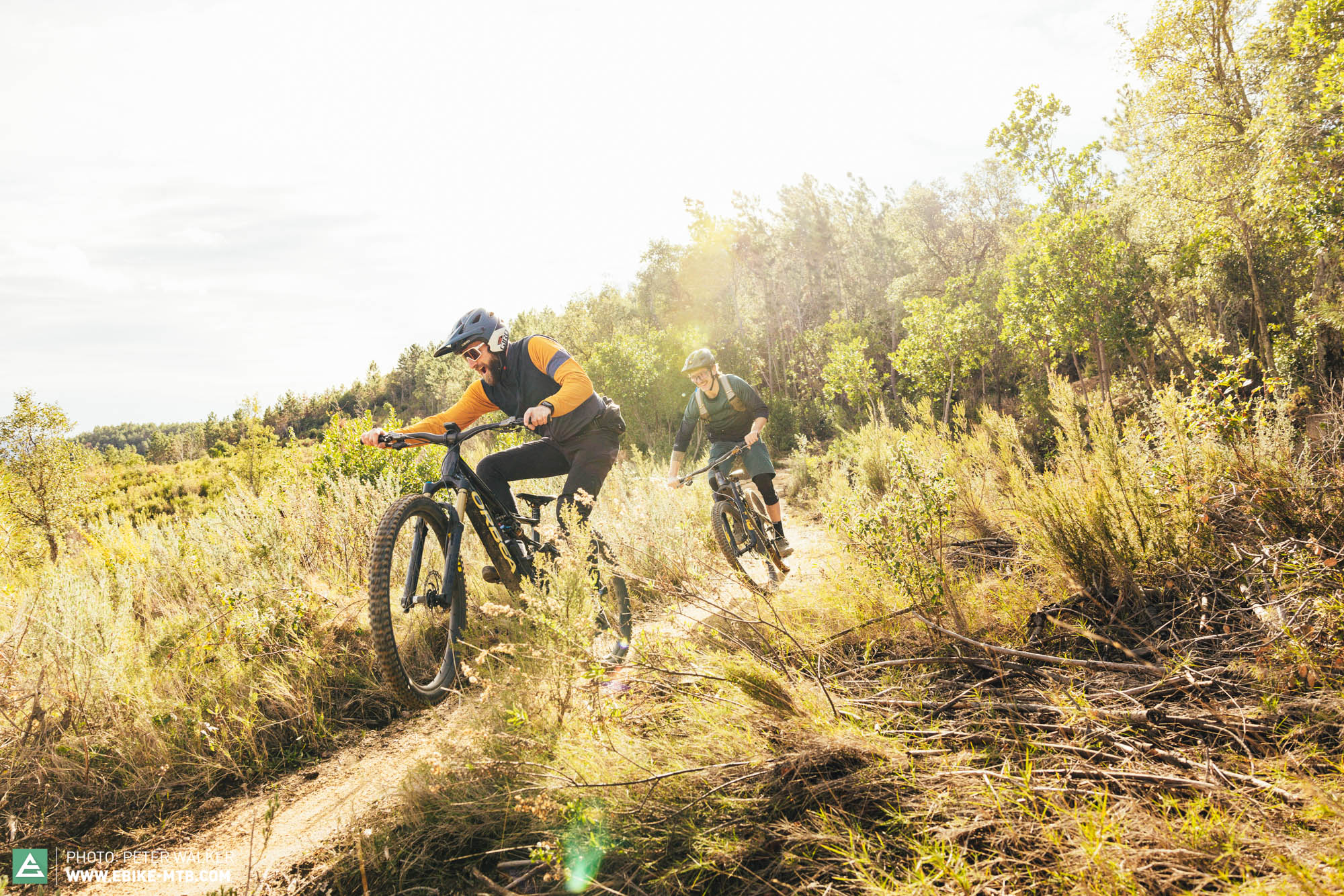
Long live this growing diversity!
The eMTB world is more diverse than ever in 2023. Although several manufacturers – and even some magazines – have suggested in the past that the range of applications of eMTBs is just as narrow as with analogue mountain bikes, that’s never been true – and this won’t change in 2023 either! On the contrary, the range of applications of modern eMTBs is growing ever wider. There are many reasons for this: for starters, e-mountainbikes are objectively more versatile, with key factors such as weight, travel and suspension efficiency having a far smaller impact on the bike’s performance compared to analogue bikes. The key criteria for a successful overall concept are, amongst others, even weight distribution, successful motor system integration and (of course) more robust components. That’s because the torque of the motor puts additional stress on the drivetrain and other performance-relevant components, and on top of that, we tend to cover longer distances with a motor.
However, there’s always an exception to every rule: Light-eMTBs, for example, deliver agile handling and very natural assistance, while the smaller motor puts less stress on the components. As a result, Light-eMTBs are more suitable for certain areas of application and enable some entirely new scenarios that are actually closer to the analogue mtb segment. Despite relying on similar motor concepts, the SCOTT Lumen and Thömus Lightrider feel like light-footed XC bikes on the trail, while the SIMPLON Rapcon Pmax TQ resembles an analogue enduro bike with its agile yet potent character. This shows how versatile some motor systems can be and how many different areas of application you can cover with just one drive. That said, it all comes down to the consistency of the overall concept and the best motor is only as good as the eMTB it’s part of.

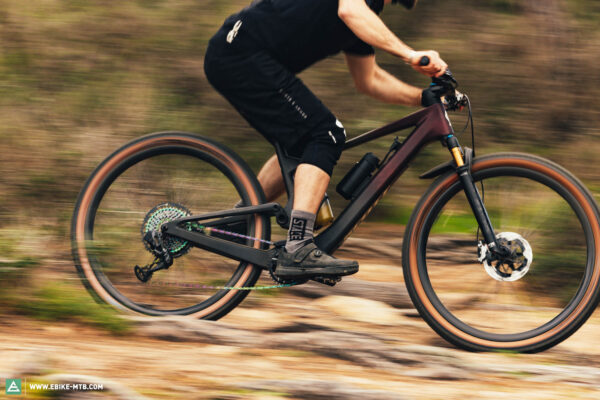
Don’t trust the looks, nor the hard numbers!
The amount of suspension travel alone doesn’t define a bike’s range of applications. In other words, there’s more to the shredding qualities of a bike than just huge amounts of travel. While at first glance, the Cannondale Moterra Neo LT1 comes across as a mean downhill machine with its beefy look and coil shock, it turned out to be the best tourer in the entire test field, combining a very comfortable pedalling position, excellent riding comfort and clever everyday features like the lighting system and battery lock. The Orbea WILD looks like a rowdy trail ripper too – and it is! However, thanks to its first-class suspension, it also impresses with good touring characteristics and proved more efficient than many of its opponents. In a nutshell, it’s impossible to determine the character of a bike solely based on the spec sheet, and the same goes for the motors! While 8 out of the 12 drive systems in this test share very similar key data, on the trail they behave completely differently. At the risk of repeating ourselves: Bosch and Shimano might share identical torque figures but have completely different qualities in all imaginable situations. With its smooth, dynamic character and broad cadence range, the Bosch motor provides a unique shuttle feeling, leaving the Shimano EP8 behind in a cloud of dust on climbs. Needless to say, the range of a bike strongly depends on the selected support mode and riding style, which in turn influences the amount of power the motor consumes. For instance, the Orbea Rise, which employs a 60 Nm Shimano EP801 RS motor and small 540 Wh battery, achieves a similar range as the BULLS SONIC EVO EN-SL 1 with a powerful 85 Nm Shimano EP801 motor and big 750 Wh battery. Simply put, isolated key figures such as suspension travel, battery size and torque alone don’t dictate the intended use and won’t tell you whether a bike is “right” for you. To find out, you should always take it to the trail!
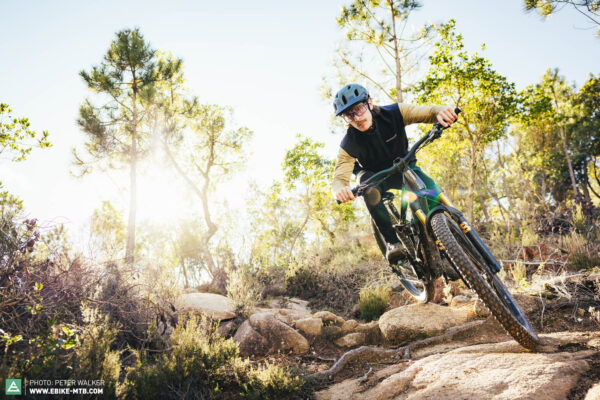
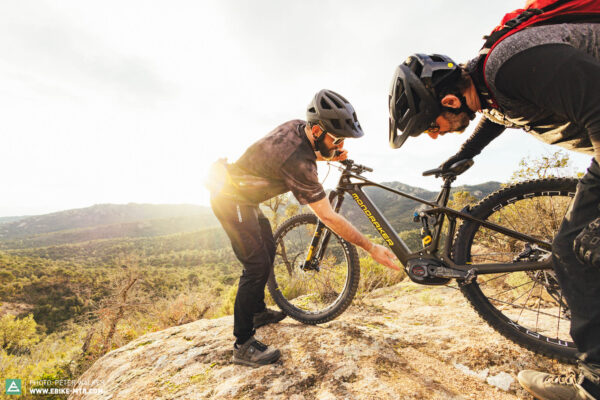
Top of the range ≠ Top performance
Flagship bike models are typically equipped with expensive, weight-saving carbon components, fancy suspension coatings and extravagant oil slick parts that (are supposed to) make a real difference on the trail. However, while lavish components might look great on a catalogue and on the shop floor, they often call for compromises in real life, both in terms of trail performance and durability. Another issue is that many manufacturers resort to deceiving builds to lure potential buyers, employing components that suggest top trail performance on paper but actually bring disadvantages to the trail. For example, with their Mondraker Crafty Carbon XR LTD, the Spanish manufacturer combines a bling SRAM X01 rear derailleur, which still seems to be a major selling point for many bike shops, with a cheaper GX shifter and even more basic NX chain. The KTM Macina Prowler Exonic comes equipped with a FOX 38 Factory fork, which hides a basic FIT4 damper beneath the fancy Kashima coated stanchions, struggling to match the excellent trail performance and adjustability of its top-tier GRIP2 counterpart. As a result, the fork fails to deliver the performance it promises at first glance – a cheaper fork with a better damper would offer better performance at a lower price. Unfortunately, this is a recurring issue we come across not only with single components, but even with the full spec on some bikes. Our test bikes from Pivot, FOCUS, Orbea and SIMPLON are also available in a more expensive spec variant, but this doesn’t bring any advantages to the trail. On the contrary: the blinger components might help save weight, but at the same time detract from the bike’s overall capabilities and trail performance – which explains why we didn’t test the flagship model of some bikes. Other competitors, like the SCOTT Lumen and Trek Fuel EXe , which entered this test in their top-tier spec variant, would have probably fared better with a cheaper spec. For instance, light tires might help reduce weight, but also generate less traction and are more prone to punctures. Even when riding primarily on gravel paths, more robust tires are worth the extra weight, adding a significant amount of comfort to your ride by permitting lower pressures. Depending on the make and model, lightweight carbon wheels might help shave a few extra grams and provide more direct acceleration, but could prove too stiff and direct on the trail for most riders. With nasty impacts, which are inevitable in mountain biking, expensive carbon rims could potentially lead to costly write-offs. For example, if you smash one of the SCOTT Lumen’s carbon wheels, which unites the rim, spokes, and hub into a one-piece carbon construction, you’ll have to fork out a whopping € 2,500 (per wheel!) to replace it. To help you save money right from the moment you buy your new bike, we’ve included several handy configuration tips.
New eMTB generations = New problems?
Rarely have we experienced as many problems and breakdowns as in our latest 2023 e-mountainbike group test. While manufacturers are slowly learning to choose the components according to the bike’s intended use, and at the same time allowing prospective buyers to tailor the spec using their online configurators, in our 2023 eMTB group test we’ve had to deal with far too many glitches, malfunctions and breakdowns – especially with the drive systems. With each new generation of motors come new functions and changes, which manufacturers manage to implement more or less successfully. In this year’s test, it became evident that quality control still doesn’t get the attention it deserves. This is true for both motor and bike manufacturers, who in some cases failed to integrate the e-components neatly and effectively – and unfortunately, there’s also plenty of room for improvement on the software side too. As a result, many products aren’t actually fit for the market! Especially with Light-eMTBs, we’ve experienced countless breakdowns and some bikes didn’t even make it half way through the test sessions.

The two faces of integration
Integration has become a hot topic over the past few years, with increasingly more manufacturers relying on internal headset cable routing and one-piece handlebar/stem units. While the latter ensure a cleaner overall look and blend in with the overall picture of the bike more harmoniously than conventional separate bars and stems, they don’t allow for fine adjustments, preventing you from adapting the cockpit to your personal needs, which is particularly important with mountain bikes! Internal headset/stem cable routing systems ensure a clean look but make it harder to work on the bike. We all love a clean look, but also like to service our bikes without going nuts.
Back in 2021, a display integrated into the top tube – see the Specialized Turbo Levo – was still a novelty. Fast forward two years, and integrated displays are fairly popular and – combined with minimalist remotes – ensure a clean look and intuitive operation without causing problems. After all, end users don’t fiddle around with their display, and integrated screens are better protected against impacts than bar-mounted models, both on the trail and during transport. However, integration doesn’t only bring aesthetic advantages but also creates real added value. While in our previous group tests only a few manufacturers – like Specialized and MERIDA – installed multi tools on their bikes, increasingly more brands are following suit: Orbea with the updated Rise, SCOTT with the Lumen and Trek with their Fuel EXe. This allows you to carry out all basic trail-side repairs without having to carry a backpack or hip pack.
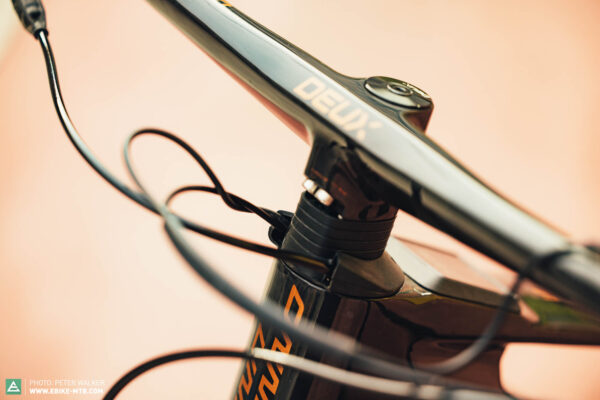
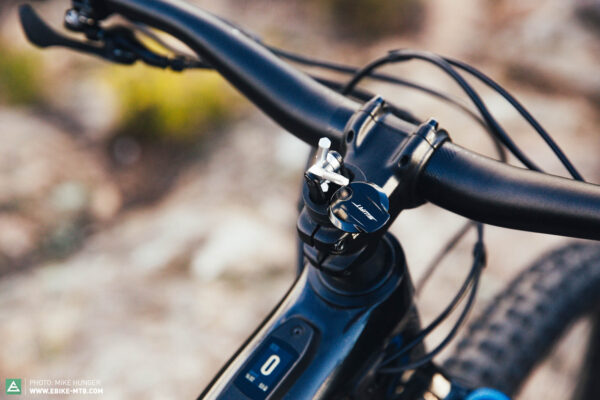
Enough is enough! We want more battery options, not bigger batteries!
Year after year, manufacturers have tried to put an end to range anxiety by producing bigger and bigger batteries. However, the industry has long recognized that more Watts don’t necessarily improve trail fun or the handling of the bike, both on and off the trail. Quite the opposite, because with the current state of the art, more capacity usually means more weight. That said, both our reader’s survey as well as the data provided by some manufacturers, showed that most riders don’t even drain their big batteries most of the time. 65% of the participants in our reader survey would like to have a battery with between 600 Wh and 800 Wh capacity in the future, while 60% of the respondents are currently using batteries smaller than 600 Wh. In other words, a larger battery is still a benefit for many people who want to upgrade to the current level of technology. Nevertheless, the industry seems to have reached a peak in battery capacity, so range anxiety should slowly start to wear off. Moreover, many e-mountainbikes are easy to pedal even when the battery is fully drained, meaning that you won’t get stranded in the middle of nowhere as you would with a car. Several manufacturers cater more to the individual needs of their customers, allowing them to choose between different battery options and offering optional range extenders to expand the capacity according to the situation. This allows them to employ a smaller and lighter main battery, which enables a lower system weight and better handling while at the same time ensuring a decent range whenever required. Alongside modular battery concepts, we’d like to see more systems that don’t necessarily require you to remove the battery for charging – because who wants to install and remove the battery from the frame before and after each ride? Moreover, locking systems that work exclusively with a key must disappear: the FOCUS SAM² and JAM² set a good example, allowing you to use the key lock only when you need it for security, while allowing you to easily remove the battery without the key for convenience the rest of the time.

What useful features should every e-mountainbike have?
Many of us use bikes in lots of different situations, from trail riding to touring and even commuting. That’s why safety-relevant everyday features like a lighting system or reflective lettering make total sense even on potent, performance oriented bikes. Such features add significant value when commuting or touring, without bringing disadvantages to the trail.


Connectivity has become an integral part of our lives and has long found its way into the eMTB segment. Using your smartphone, you can control and adjust countless functions, although this requires you to manage several different apps. We’d like to have one app for everything, like Trek’s Central app, which can be used to fine-tune the motor characteristics, check the air pressure on both the tires and suspension, and even to navigate! In addition, many apps are still incredibly confusing, taking far too much time and patience to navigate your way around them. A detailed analysis of the rider’s performance could also help us overcome range anxiety, which is deeply ingrained in eMTB culture.
When stopping for a cheeky post-ride pint at the pub or in a mountain hut, the last thing you want to do is worry about your two-wheeled darling, regardless of whether it cost you € 5,000 or € 15,000. So we kindly ask manufacturers to provide their bikes with theft protection, like Bosch does with their eBike Lock and the loud eBike Alarm. An optional GPS function would provide additional security. However, manufacturers should work harder not only to improve the connectivity of the bikes but also their quality control procedures. Especially with the latest generation of Light-eMTB motors, we’ve had far too many issues, and in our opinion, many bike models simply weren’t ready for production, with over 50% of the Light-eMTB test field having rather serious problems and, in some cases, not even making it to the end of the test session in one piece. With an average price of €12,394, this is unacceptable and more than just disappointing! Even if you’re a keen early adopter of new technology, you’ll have to think twice! And that’s a real bummer not only for the end user, but also for the motor and bike manufacturers themselves, because every single flaw (and the resulting delays) causes additional effort and costs. Simply put, it all gets a little too expensive! Ebikes are extremely complex, especially in terms of compatibility and software, demanding a whole different level of quality control/management. But there’s also some good news and hope in the form of software updates that can remedy the situation.
The fact is: the 2023 eMTB world is more diverse than ever. While the products are getting generally better, some bikes don’t work as they should! Some manufacturers still have to do their homework, because this approach is highly detrimental to the entire eBike segment. “Fail fast, learn faster” is still the safest route to growth. The good news: many e-mountainbike manufacturers are on the right path, not only because they’re developing plenty of exciting new features, but also because they’re constantly improving their organisation, development and production process and infrastructures, which is the foundation of a better user experience!
Did you enjoy this article? If so, we would be stoked if you decide to support us with a monthly contribution. By becoming a supporter of E-MOUNTAINBIKE, you will help secure a sustainable future for high-quality cycling journalism. Click here to learn more.
Words: Mike Hunger Photos: Peter Walker, Mike Hunger









